|
|
|
If this page is helpful,
please Share it:
|
 |
The Flow of Energy Through Plants and Animals
The energy flow through living organisms starts
with sunlight and photosynthesis, then travels through the food
chain in bite sized chunks. Primary producers, primary consumers,
secondary consumers, and decomposers are all part of the food
chain.
It's great to be an Omnivore.
Science and technology education from FT Exploring. |

|
 |
 |
 |
 |
 |
 |
 |
 |
 |
 |
| |
Photosynthesis, Energy, and Life - Page 2 |
|
 |
 |
 |
 |
 |
|
|


If this page is helpful,
please Share it:

If this page was helpful,
please Share:
|
| |
| |
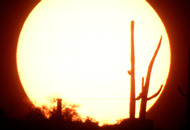 Except for a few
exceptions, all of the energy for all life and
human technology comes from the SUN.
Except for a few
exceptions, all of the energy for all life and
human technology comes from the SUN.
Animals and humans can't eat
sunshine. Plants are the first level in the food
chain. They convert sunlight to food for animals
(though the plants may not look at it that way).
|
|
 |
 |
 |
|
| |
The
Mysterious Everything
flows
in bite sized chunks (literally) through life, from one
living thing to another living thing to another 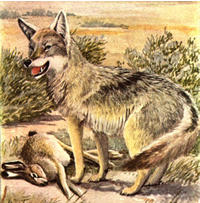 living thing, and so on and so on, but not forever. ("Energy's
One Way Trip"). Matter
also flows through life, but in this section we are only
talking about energy.
living thing, and so on and so on, but not forever. ("Energy's
One Way Trip"). Matter
also flows through life, but in this section we are only
talking about energy.
This flow of energy
is transported through the animals by a system biologists
call the food chain. A food chain in a
given ecosystem is usually very complicated but it is useful
to think of the food chain in the four simple steps or levels
described below.
The drawing below only shows
three steps. Which one is missing?
Scroll
down to read about the 4 food chain steps...
|
|
 |
 |
 |
|
|
| |
The flow of energy through life is not an endless
cycle. The energy doesn't go round and round
getting used over and over again and never wearing
out. Its passage through the food chain
can better be described as in and out.
As energy moves up the
food chain there is less and less of it to go around.
That's the main reason there aren't very many
big fierce predators compared to the herbivores. Not
enough energy for them! We'll talk
about this in detail in another section, but a brief
explanation goes something like the following:
Most of the solar
energy that falls on the earth is not used by
plants. It bounces back to space or heats the air,
oceans, and ground, and makes weather, among other
things.
Sooo....
The plants only
get a little bit of the solar energy that hits the
earth.
And....
The herbivores
only get a little bit of the energy that hits the
plants.
And....
The carnivores
and decomposers only get a little bit of the
energy that was eaten by the herbivores.
(Most
of the plant energy that is consumed by a herbivore
is used by that herbivore to keep itself eating, breathing,
walking, and staying warm. Only a little bit is left
over for the carnivore or decomposer that eats the
herbivore.)
Sooo...
At the end of the chain there
isn't much of that original solar energy left.
Therefore....
We need fresh sunshine
everday and new plants have to keep growing. Otherwise
the whole amazing system would quickly run out of
energy and everything alive would come to a "dead"
stop.
|
|
|
 |
 |
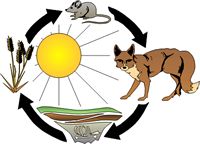
Energy
above flows (or jumps in bites?) from sun to primary producers
(plant) to primary consumers (mouse) to secondary consumers (coyote)
to decomposers (bacteria, etc.)
|
Picture of a Food Chain
Energy flows
from the sun to the plants to the plant eaters to the meat eaters.
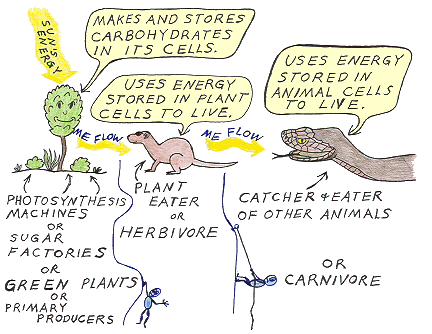
1) Primary Producers -- Green
plants and certain types of bacteria and  algae are the primary
producers because they are the ones that produce
usable energy for the rest of the living organisms on
earth. They use energy from the sun to make sucrose,
glucose, and other compounds that other life forms
can eat and "burn" for energy. In each
one of those sugar molecules a little bit of the sun's
energy is stored in a form that we can call chemical energy.
But it might better be called "potential energy"
since it is a sort of "doing-nothing-for-now-waiting-to-happen"
kind of energy (for more on this visit Energy
Changes).
algae are the primary
producers because they are the ones that produce
usable energy for the rest of the living organisms on
earth. They use energy from the sun to make sucrose,
glucose, and other compounds that other life forms
can eat and "burn" for energy. In each
one of those sugar molecules a little bit of the sun's
energy is stored in a form that we can call chemical energy.
But it might better be called "potential energy"
since it is a sort of "doing-nothing-for-now-waiting-to-happen"
kind of energy (for more on this visit Energy
Changes).
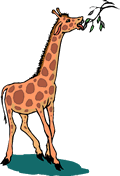
2) Herbivores
- Herbivores are the plant eaters. They
have the ability to digest the plants they eat and release
the energy stored in the plant cells for their own use.
Some examples of animals in this group are deer, cows,
elephants, rabbits, elks, zebras, most insects, and birds
that eat fruit and seeds. Sometimes scientists call this
level of the food chain the Primary
Consumers (sounds like Economics class).
3)
Carnivores
- These guys are the meat eaters. Predators
and scavengers are in this group. Sometimes
this level in the food chain is refered to as the Secondary
Consumers. They eat the guys
that eat the plants and sometimes they eat each other.
Most of these animals can't eat plants at all. They
would starve to death if it weren't for the Herbivores
digesting the plants first. They've got the
glamour job but they're really pretty helpless without
all the boring plants and herbivores.
refered to as the Secondary
Consumers. They eat the guys
that eat the plants and sometimes they eat each other.
Most of these animals can't eat plants at all. They
would starve to death if it weren't for the Herbivores
digesting the plants first. They've got the
glamour job but they're really pretty helpless without
all the boring plants and herbivores.
Cats
and dogs, killer whales, sharks, spiders, snakes, wolves,
vultures, hawks, eagles, crocodiles, and many other fierce
predators that for some reason we are especially fascinated
with, are in this group.
4) Decomposers
- These are not the guys that sit around unwriting songs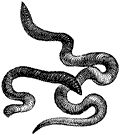 and symphonies (get it? The opposite of composers?). They
are the guys that eat up dead bodies - both plant and
animal. And aren't we glad they do. This group
of useful critters are mostly
bacteria and fungus, but also, according to
our sources, includes maggots, dung beetles, earth worms,
sow bugs (shown below), and many other eaters of dead
organic matter. Without them there would be a lot
of dead bodies lying around.
and symphonies (get it? The opposite of composers?). They
are the guys that eat up dead bodies - both plant and
animal. And aren't we glad they do. This group
of useful critters are mostly
bacteria and fungus, but also, according to
our sources, includes maggots, dung beetles, earth worms,
sow bugs (shown below), and many other eaters of dead
organic matter. Without them there would be a lot
of dead bodies lying around.
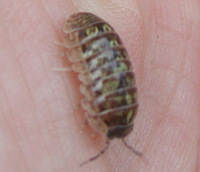 They're
like carnivores and herbivores, because they also have
to get their energy from the cells of animals or plants.
The difference is they prefer their food dead - very dead. They're
like carnivores and herbivores, because they also have
to get their energy from the cells of animals or plants.
The difference is they prefer their food dead - very dead.
What do you think? Are
maggots decomposers or carnivores (or just yucky little
things we'd rather not think about)? |
|
|
| |
| |
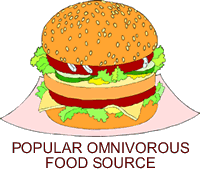 Hamburgers are for Omnivores
Hamburgers are for Omnivores
Some animals can eat plants
and other animals. So you could say they are both
a herbivore and a carnivore. That's the way humans
are. We can eat plants and we can eat meat. La tee da.
It must have been too
difficult for biologists to say herbicarnivore or carniherbivore,
so they decided to call humans, and others like us, omnivores.
It means we'll eat just about anything we can get
our amazing opposable thumbed hands on.
Black bears and brown bears
are in our omnivorous club. And pigs we think. Can
you think of any others?
I can't think of anything
better than being an omnivore. We can be either primary
or secondary consumers. It's so empowering!
|
|
 |
 |
 |
|
|
|
 |
 |
 |
 |
 |
|
|
| |
|
| |
| |
Its been estimated that one large maple tree, with 500
pounds of leaves (fun raking in the fall), can make two
tons of simple carbohydrates (sugar) during one nice sunny
day!
How many tons would that be in a
month of sunny days? |
|
 |
 |
 |
|
| |
|
|
| |
It starts with the sun. The Mysterious
Everything, that makes everything happen on Earth,
flows continuously from the sun to the earth.
All life needs energy to live, and the
energy we need comes from the sun. Unfortunately,
we crawlers, slitherers, walkers, and flyers, can't get
nourishment from the sun without some help.
We can stand in the sun all
day, get warmed by it, even get a good sunburn, but we won't
get nourished.
|
|
 |
 |
 |
|
|
| |
What
do green plants, blue-green algae, and a few
types of bacteria, have in common?
They are the only organisms that
can turn sunlight into the little energy storage packages
that we call sugar. If it wasn't for them the
rest of us would go hungry because we can't live without
those little sugar molecules that only they can provide.
Do plants seem a little boring?
Sitting in one spot all day long, growing ever so slowly.
Like watching grass grow, they say.
Well they aren't moving fast, but
they are busy. When the sun is shining, they're doing photosynthesis,
furiously turning sunlight into stored energy that all the
non-plants need for survival. Every day they turn
the sun's energy into millions of tons of sugar. |
|
 |
 |
|
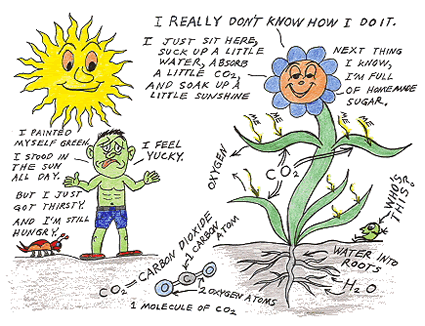
 |
 |
 |
| |
"Energy,
energy, everywhere, nor any drop to eat". (with apologies
to Samuel
Coleridge).
Our mostly stationary green friends
come to the rescue. They take a little sunshine from
the sky, a little carbon dioxide from the air around them,
a little water from the surroundings, and they turn those
basic ingredients into little parts of themselves that we
call plant cells. This process is called
photosynthesis. (They
also make and release a useful little gas called oxygen
during photosynthesis.)
Each one of those plant cells contain
little packets, or molecules, of stored energy that we call
carbohydrates. Some
of the most important and simple types of carbohydrates
are called sugars. One of the most important sugars
for animals and humans is glucose.
|
|
 |
 |
 |
|
|
 |
| |
|
|
|
 |
 |
 |
 |
 |
|
|
|
©Copyright 2014.
David E. Watson. All rights reserved. Everything
in the Flying Turtle web site is copyrighted. For information
concerning use of this material, click on the word Copyright.
|
|
|
|
| |
|
|
 |
 |
 |





